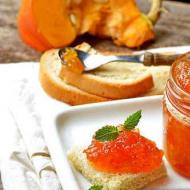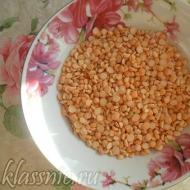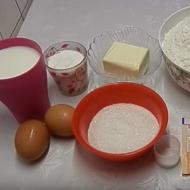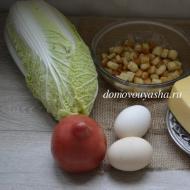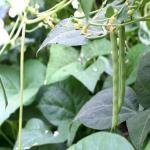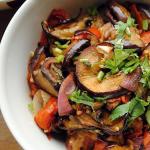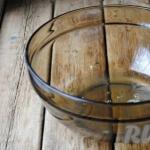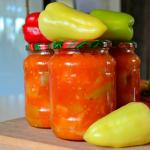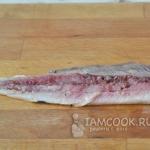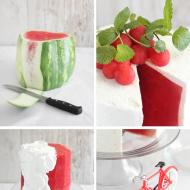
Moonshine on oak chips - homemade cognac and whiskey. Recommendations for the use of oak chips Thermal treatment of oak wood
Cognac deservedly takes first place among strong alcoholic drinks in terms of its taste and aromatic qualities. Its production is a complex and lengthy process, consisting of two stages: distillation of white grapes into cognac spirit and aging in charred oak barrels. This technology gives it a delicate amber color, fruity aroma and a pleasant aftertaste.
More than half of the noble drink on the alcohol market is a fake, which is a hellish mixture of low-quality alcohol, dyes and flavors.
With a little effort, you can actually prepare oak chips, the quality of which is not inferior to the original, which is not scary to treat guests at home celebrations.
Homemade moonshine tinctures are not for beginners in moonshine making, but for real professionals who have learned how to distill a quality product.

Using the infusion method you can get any drink - from cognac to tequila, it all depends on the ingredients added. For this purpose, only double-distilled moonshine with a strength of 45 degrees or more is suitable. The second distillation of pre-filtered moonshine is very important, since the output is a safe distillate, purified from toxic fusel oils.
During the infusion process, the distillate absorbs the essential oils of the additives placed in it, and turns from moonshine into an aromatic and tasty drink.
Very important stick to the tincture recipe so that the wrong technology does not ruin all the work, although experiments are acceptable within reasonable limits.
One of the best infusion methods is oak infusion, and here's why:
Advantages of raw materials
Oak changes the properties of moonshine for the better. Oak wood is an excellent adsorbent and absorbs harmful substances, which could not be removed during the distillation process. In addition, it is rich in resins, fats and tannins, which soften moonshine and give it healing properties.
Since infusing moonshine in an oak barrel to obtain cognac requires a lot of time, at least 30 months, folk craftsmen have invented an accelerated method - infusing oak chips or bark, which, with proper preparation, are a good alternative to aging in a barrel.
Instructions for choosing a base
Buying oak chips is not difficult; they can be ordered online, but it will be buying a pig in a poke, since you cannot be sure of the quality of the product. Chips of varying degrees of roasting can be bought in stores for distillers, or you can make them yourself.

Choosing a tree type
The place in which the tree grows is of great importance, since the properties of the drink directly depend on this. It is advisable to infuse oak chips that grew in a dry climate on poor soils, otherwise the wood will be overly saturated with tannins and spoil the quality of the cognac.
Of the species, the well-known pedunculate oak is suitable for all of us; it is the most common in the European part of Russia and in Europe. This oak has two varieties:
- Summer. Blooms from mid to late spring.
- Winter(or stone). Blooms in early summer.
Both varieties have medicinal, phytoncidal, coloring and tanning properties.
Video on the topic:
We prepare raw materials
First, you need to decide what wood chips are and what chips are. Oak chips are a semi-finished product, a blank, so to speak. In order for them to become chips, they must be pre-processed according to all the rules. and then fry in the oven:

During roasting, some of the tannins in the wood magically turn into vanillin, and the sugar caramelizes; if you char it, all the aromatic substances will simply burn out.
Reference: By infusing the same moonshine on chips of different degrees of roasting, you can get drinks that are completely different in smell and taste:
- Chips kept at a temperature of 160° give the distillate sweetness and a pronounced oak aroma of carpentry; people call this moonshine “plintusovka”;
- At a temperature of 180° they give the aroma of vanilla and roasted almonds;
- 190 - 210° - caramel aroma with subtle notes of licorice and ash.
Harvesting bark
An easier way to tincture on oak is to tincture on the bark. Oak bark contains the same tannins and aromatics as wood, only in higher concentrations, and never gives moonshine the taste of wood.
To prepare the drink, a pharmacy grade one is quite suitable; you just need to sift and rinse it; no soaking or frying is needed.
If you have time and desire, you can prepare oak bark yourself. This is done only in the spring, when the tree wakes up, the flow of sap in it resumes, and buds appear. The greatest amount of useful substances is contained in young bark, but young oak trees cannot be stripped, as this will lead to their death.
Young branches of an old tree are perfect for this purpose:
- make two cuts around the circumference of the branch, with a distance of 20-30 cm;
- make a longitudinal cut between them;
- remove the bark;
- dry in a dry, dark, well-ventilated place;
- Grind before use.

How to insist?
The best liqueurs made with oak chips are made from grape moonshine. It is tasty and aromatic in itself, and with long interaction with oak wood it is further enriched with fruit, vanilla and chocolate notes. But if there is no such distillate, one made from fruits, grains or sugar is quite suitable.
The strength of the moonshine is also important; the higher the percentage of alcohol, the better the result:
- 53-63% - tincture with a vanilla-nut scent;
- 45-52% - sweet vanilla;
- 40-43% - sweetness without a pronounced aroma.
You can determine the required amount of oak chips to saturate the distillate experimentally - on average 25 g per liter, an indentation in one direction or another is acceptable, but it is better not to report than to shift. Even repeated distillation will not help moonshine spoiled by a large amount of oak - the taste and smell will remain unpleasant.
The infusion time is not limited - within 2 months, oak chips give up most of the chemical compounds, after which they can be thrown away or replaced with fresh ones.

Herbal healing cognac
When infused, all the beneficial components from medicinal herbs pass into liquid. Amino acids, vitamins, microelements, tannins and essential oils retain beneficial properties for humans. When consumed in moderation, this cognac has an immune-strengthening, restorative and calming effect.
Components:
- Purified moonshine - 1.7 liters.
- Honey – 3 teaspoons.
- Bay leaf, black pepper and allspice (peas) - 3 pcs each.
- Vanilla and cinnamon - a pinch each.
- Oak bark, dried rose hips, St. John's wort, oregano - a tablespoon of each.
Cooking technology:
- The pepper is pre-crushed.
- All dry ingredients are poured into glass or ceramic containers.
- Fill with moonshine.
- Cover with a lid and shake.
- Leave the cognac in the dark for 3 days.
- Add honey and stir it.
- They insist for another day.
Strain through a cloth and leave at a temperature of +5+7°C for another 2 days.
Cognac "Juniper"
The drink has a pleasant “Christmas tree” aroma and a light resinous note. Its taste is quite rich and even dense. This option is ideal for gatherings in a male company. You can buy dry juniper berries at any pharmacy. They are sold at any time of the year.
Components:
- Purified moonshine – 2 liters.
- Juniper berries – 14 pcs.
- Lemon zest – 4 slices approximately 2*2 cm.
- Honey – 2 tablespoons.
- Oak chips – 50 gr.

Manufacturing technology:
- Chips are added to moonshine and infused for 2 months.
- After this period, take them out and add honey and zest.
- The berries are crushed with a rolling pin and poured into moonshine.
- After 3 days, the zest is caught so that it does not give the drink an overly citrusy smell and a specific lemon bitterness.
In total, from the moment of adding juniper, the cognac is infused for 10 days, and then filtered and brought to readiness in the cold for 24-36 hours.
There is also a faster cooking option. Only it uses not chips, but oak bark, or rather its decoction. Pour boiling water over a tablespoon of raw material, wait until it cools down, and filter. The liquid is poured into a container with moonshine. Otherwise the process remains identical to the first recipe.
For a more feminine option, you can add a cinnamon stick to the tincture, and use the resulting cognac to make cocktails. For 50 gr. For an alcoholic drink, take 200 ml of grapefruit Schweppes, tonic, Sprite - any drink with a citrus flavor.
Making cognac on chips - the best recipe
The most common recipe for homemade cognac is quite simple, and consists of only two ingredients - oak chips and strong grape moonshine:
- put the required amount of wood chips into a container with distillate at the rate of 25 g per 1 liter;
- Close tightly and store in a cool, dark place for at least 2 months;
- check how the process is going and take a sample every 7 days;
- After the drink has matured, remove the chips, bottle the cognac and leave for another 5 days to stabilize and develop the taste.
Latgale cognac
Latgale cognac is a simple and tasty drink that even a beginner can prepare. To do this you will need:
- 3 liters of moonshine, at least 50% strength;
- 2 tbsp. l. oak bark;
- 3-4 cloves;
- half a gram of nutmeg;
- coriander (on the tip of a knife);
- 3 tbsp. l. Sahara.

Dissolve sugar in 100 g of moonshine, pour the syrup into the bottle and add the remaining ingredients. Leave for at least a week, but no more than a month.
There are many recipes for homemade oak infusions - a variety of herbs rich in essential oils allows you to create drinks that are unique in taste and aroma, and preparation brings pleasure, enhanced by the anticipation of the result.
Video about infusing cognac on oak bark:
Konyakh-three days
This recipe differs from all others in the short preparation time of the desired drink.
Components:
- Purified moonshine – ½ liter.
- Black loose leaf tea without additives or flavorings – 1 teaspoon.
- Vanilla sugar and cinnamon - 1/6 teaspoon.
- Oak bark – 1 tablespoon.
- Black and allspice peas – 3 pcs each.
- Dry St. John's wort - 1/3 of a tablespoon.

Cooking technology:
- St. John's wort, bark, and tea are poured into a clean jar.
- The pepper is crushed into a not too fine fraction; just press it down with a tablespoon.
- Add pepper, cinnamon and vanilla sugar to the dry mixture.
- Pour enough moonshine into the jar so that all the components float freely and shake the container.
- Add the remaining amount of alcohol base.
- Cover the jar and leave it to infuse for three days.
After the allotted time, it is taken out; during this period, the cognac should acquire a rich brown-amber color. The liquid is filtered through a sieve. For control, you can add a layer of cotton wool or gauze to its lattice. The cognac is aged for another day - two in the refrigerator and you can enjoy the result.
Cognac "Sibirsky"
Nutwood tincture has been made in Siberia since ancient times. The cognac version is milder in taste. It helps normalize blood pressure, increase overall tone, potency in men, and improve digestive processes. All this, of course, with moderate doses of use.
Components:
- Moonshine – 0.5 liters.
- Pine nuts in shell – 50 gr.
- Oak bark infusion – 100 ml.
- Honey or sugar - 1 tablespoon.
- Blackcurrant leaf – 2-3 pcs.

Cooking technology:
- Oak bark (1 tablespoon) is brewed in 100 ml. boiling water, infused, passed through cheesecloth.
- The infusion is mixed with honey and poured into moonshine.
- Add nuts and pre-crushed currant leaves to the jar.
Let it brew for at least 14 days and filter. Bring to condition for another two days, keeping the drink in the cold. You can make this cognac from moonshine on oak chips. It will take, of course, more, but the taste of the drink will be more subtle and noble.
It is very important to select and use quality pine nuts. They must be tasted before adding to the drink. Rotten nuts with a bitter taste or chemical, rubbery notes of taste and smell will not only spoil the future cedar cognac made from moonshine on oak chips, but can also be hazardous to health.
Drinks infused with oak chips, noticeably differ in elegant coloring and transparency, greater fullness and coherence in taste, a bright bouquet, floral, honey and fruit aroma, reduced “fusel” and “ether-aldehyde” tone, intensive maturation of wines and cognac spirits.
Oak products, due to their unique properties, are used all over the world in the production of wines, cognacs, whiskey, Calvados and many other alcoholic beverages. Its main components that enhance wines and cognacs are: phenolic substances (tannins), fats, resins, and flavor-forming substances.
Oak chips- a completely natural, environmentally friendly product. No additional substances that increase oak aroma or increase the extract content of substances are used in production. For production oak chips Only the lower part of an oak trunk, 90-100 years old, is used.
Oak chips will give your moonshine the effect of aging in! The technology of using oak chips has been successfully introduced by winemakers at wine and cognac enterprises around the world! It’s very simple to start your own production of aromatic alcoholic masterpieces!
Way infusing moonshine on oak chips: add one heaped teaspoon to 1 liter of moonshine (alcohol) with a strength of 40-50 vol., leave for at least 4 weeks, then strain.
The topic of making oak chips (chips) worries many. In this short article, I tried to collect the main points and share a couple of practical tips not discussed previously.What are oak chips used for?
Oak wood is used not only at home, but also in wineries, distilleries and even in the most ordinary distilleries. The main task is to bring the taste and aroma characteristics of the drink closer to those aged in barrels, to saturate the drink with chemical compounds of oak. I'll be honest and honest, the use of oak wood in the form of chips or staves will never compare with drinks matured in a barrel. The point is not in the chemical composition of oak, but in the physical and chemical processes occurring in an oak barrel, some of which will not occur if oak wood is immersed in a container with a drink. This method appeared in industrial production to speed up and reduce the cost of drinks, and only then in the arsenal of the home distiller.
How to choose oak
This is the very first question I come across. First of all, the oak should not be young; it is best to take it from trees with an average age of 100 years; they have already accumulated a sufficient amount of various chemical compounds and the tree itself, in terms of its size, is already “ready” to serve man as a building material. I don’t suggest taking a hatchet and walking into the forest; distillers are peaceful people by nature, they treat nature very carefully and the most they can do is pick up an old, dried tree. So, green citizens, this material will definitely not raise any doubts in you. .. Carpentry workshops are the richest source of wood; there you will definitely not find boards from young trees; you will definitely make sure that the wood has not undergone any processing other than cutting tools. Construction stores are possible, but very carefully. Frequently sold oak boards, dies, plinths and arches. joinery products are treated with substances that highlight the texture of the wood or give it a more attractive appearance. Choose only those joinery products that are guaranteed not to have been treated with special solutions. The cooper's shop is a reliable source, here you definitely won't miss, and maybe you'll even buy a barrel. It would take a long time to describe other options, someone is dismantling a fence or other building, and someone is even knocking out stools... but I repeat once again - you must be sure that the wood was not covered with varnishes, paints, impregnations, drying oils and other materials suitable for construction . Let's assume that you have already found oak wood.
Preparation of oak wood
First of all, the wood needs to be chopped. It is better not to make sawdust; it will be enough to make small flakes (chips) or chop thin bars with a cross-section of 1-2 cm. After everything has been chopped and sawn, the most interesting moment begins with the question - what is the best thing to do? In this case, there is an exact recipe that I have verified over the years. Take some chips or a couple of small blocks with a total surface area of 140 square meters. see, brew them in 2 liters of boiling water and wait until it cools down. If the water turns dark brown (the color is similar to burnt sugar dissolved in water), you will have to reduce the saturation of the wood by boiling it down; if it turns amber, you can skip it and go directly to heat treatment. We often have the opportunity to find oak boards that have lain under the sun and rain for several years; it would be better if you do a preliminary check in the manner described above, otherwise there is a chance to get wood with the minimum amount of chemical compounds we need. Looking from the other side, we don’t need a high content of chemicals, including tannins. The task is to create an imitation of an oak barrel already prepared for filling with distillate.
Digesting excess tannins. I know of two simple and proven methods. The first consists of briefly boiling the wood in ordinary water and changing the water up to several times. The second method is to speed up the process and add sodium bicarbonate to the water; a weak alkali is formed in the solution with water and the digestion process is accelerated. The whole process is described in detail in where you can discuss any questions you may have or offer your own option. Having determined the remaining amount of chemical compounds in the wood, you can proceed to heat treatment.
Thermal treatment of oak wood
Heat treatment is necessary for the chemical reactions of the substances contained in oak wood; by adjusting the processing temperature we can obtain several basic aromas. It should be recalled that each tree differs in its chemical composition, the aromatics may differ in one direction or another, below are relatively objective data, but do not claim to be a standard. I will not describe all the chemical reactions that occur; they are complex for the untrained reader and are quite well described in the specialized available literature. Anyone can find this information easily.
While doing heat treatment of oak wood, I experimented a lot, turned to coopers and literature, and here is the result: Before starting heat treatment, you need to dry the oak after boiling; you can dry it in various ways, from heating in the oven at relatively low temperatures to 150 ° C, to the most accessible - in the air. If the wood is completely dry, it will be better if you wet it a little, this way we will ensure better interaction of chemicals with each other, chemical reactions will occur faster, and by adjusting the temperature, you can get several different aromas from one tree.
Oak chips without heat treatment astringency, milky tones, mushroom notes, coconut. I recommend it only for future blending in a small amount from the main distillate.
160° C (15-25 min) “Flat” aroma of woodwork, bright oak aromas, sweetness. It has become popularly known as "plinth" Only for future blending.
180° C (10-15 min) Vanilla, toasted almonds, sometimes white toast aroma, sweetness. For the main distillate.
200 -210° C (10-15 min) Caramel aroma, subtle hint of licorice, ash, sometimes harsh aroma of smoke. For the main distillate.

Having prepared the wood in this way, we can assume that everything is ready, but this is a common mistake; simply throwing wood into the distillate can ruin everything. Below I will give some recommendations. First of all, you need to decide how much to saturate the distillate, there is no definite answer, you can experiment at your own discretion, but as my personal practice and “walking on a rake” have shown, the average contact area of oak wood with the distillate is 70 sq. cm. 1 liter of distillate. You can retreat in one direction or another, but when experimenting, it’s better to retreat to a smaller one; it’s never too late to add, but if you shift too much, it will be impossible to correct it. Even if you distill a spoiled drink, its taste and aroma properties will change for the worse. Start with one teaspoon of chips per liter of distillate, and let it sit for two weeks, this way you will be relatively precise about how much to add so as not to spoil the drink.
Maturation process with oak chips
By adjusting the percentage of alcohol in the distillate, you can achieve quite interesting results.
Two months of ripening
☑ 53%-63% This will ultimately lead to a vanilla aroma and nutty overtones.
☑ 45%-50% Will give a mixture of vanillin and sugar.
☑ 40%-43% Will give sugar without pronounced vanilla or nut aromas.
The ripening time interval is not limited, small chips and thin bars will give up almost all of their chemical compounds in an average of 2 months, they can be removed or added fresh, but this is only the first step, how long your drink will ripen - the choice is yours.
Experimental options

The treated wood is immersed in wine, kept in it for a week or two, washed with hot water, and freed from tartar if the wood is immersed in fermenting wine. I call this method like with like. If I make it from the variety I have chosen, I often add wine, so oak wood “flavored” with the same grapes is placed in the distillate, and after ripening the distillate acquires a bright, rich aroma. This is a wide field for experimentation. When experimenting, do not forget that oak wood that has been in wine may contain acedobacteria; before immersing it in the distillate, make sure there are no side aromas or heat it again at 180 ° C for 5-7 minutes.
I hope you found this information useful. You can discuss it on the forum, suggest your own version, criticize or like it in the footer of the site.
Chips for aging alcoholic beverages must be made from high-quality oak wood that is at least 90-100 years old. Only the lower part of the trunk is used - up to 7 m in height.
No additional substances that increase the oak aroma or increase the extract content of substances are used in production - oak chips are a completely natural product.
On average, 300-500 g of wood chips are used to keep 80 liters of drink.
The effect of roasting level on the drink:
Lightly fired - subtle hints of vanilla, fruit and flowers
Medium roasting - bright aroma of vinyl, almond, coconut, spices, caramel.
High firing - rich smoky, chocolate effect.
Light, medium and high firing
Unburnt wood chips
Uncharred wood chips used during alcoholic fermentation improve the tannin structure and stabilize the color of red wines. The aroma profile reflects the characteristics of fruit and almond with a slight oak tone. You can also note an increase in the intensity of the aftertaste.
Burnt wood chips
The combined use of medium and deep roast wood chips during aging increases the aromatic complexity of the wine. Medium-fired wood chips enhance the sweetness and oak flavor. Highly fired wood chips have an intense aroma with a predominance of vanilla tones and a strong oak tone in the taste.
Table: quantity of oak chips for cognac or wine and required aging time:
The best results were obtained when using:
- for processing white tableware (dose 0.3 - 1.0 g/dm3), holding time - 6 - 12 days;
- for red table fortified and dessert wines (dose up to 1 g/dm3) - aging time 6 - 30 days;
- for cognac and calvados alcohols (dose 5 - 30 g/dm3) - minimum aging time - 3 - 6 months.
The standard dosage is from 0.5 to 4 g of chips per 1 liter of wine. In fact, the decision is left to the winemaker. The dosage depends entirely on the desire to impart a rich oak tone to the wine. It is also possible to prepare a concentrate in a small volume of wine with a high dosage of chips (approx. 10g/1litre), and then blend it with the rest of the wine. The properties of the chips are similar to those of the new barrel, which has more intense aromatic characteristics.
Unfried or lightly fried chips are recommended for alcoholic fermentation. Medium and strong types of roasting are used during wine aging.
Before the start of alcoholic fermentation, chips or powder can be added to the wort or pulp. Oak tannins will help stabilize color and lock in the fruity aroma of the wine. At the end of fermentation, the chips will add a complex aromatic profile and roundness to your wine. During aging, the chips allow the manufacturer to monitor the development of oak aroma tones. By using a medium to high roast blend, you can control the oak flavor in your wine.
Can be added freely, to a container or barrel. You can also use fabric containers made from porous material. Cotton bags for food use are also available, both empty, which can hold the desired number of chips, and pre-packed bags of 6 kg each (3 bags per box). In order to improve the exchange between oak and wine, we advise winemakers not to overfill the bags.
Oak shepa is not made sterile, but it is cleaned well enough and therefore does not require special processing. But if you are not sure about the storage conditions and want to avoid any problems, you should rinse it for 5-7 minutes in sulfated water at room temperature in order to avoid too much loss of its aromatic properties. And you need to keep in mind that due to the risk of producing some phenols, which give off-tones, you should avoid washing oak chips with chlorinated water.
If you use oak chips during fermentation, they should be kept in a container throughout the fermentation period. If you are using chips when aging wine, the contact time is between 3 and 8 weeks, depending on the intended purpose. The extraction takes place quite quickly (from 1 to 4 weeks depending on the size), but more time is needed to assimilate the extract with the wine.
Re-using fine oak chips is not advisable, since the chips are quite thin, the drink penetrates through the chips and extracts all the necessary components in a short time. And larger oak cubes and bars can be reused.
Recipes:
Cherry wine on oak chips
Cherry – 1 kg
Vodka – 400 ml
Cinnamon – 1.5 g
Nutmeg - 1 g
Sugar - 250 g
Oak chips
Cover the cherries, crushed together with the pits, with gauze and let stand for about 2-4 days so that the cherries ferment. Then pour sugar, spices, vodka and cherries into the container. Cover with a lid and leave for about 6-18 days.
At the next stage, it is necessary to filter the tincture and bottle it, adding oak chips at the rate of 12-14 g per 3 liters of cherry liqueur.
Leave to ripen for at least a month.
Cherry liqueur made with oak chips will have a pronounced cherry flavor, light sweetness and tartness, thanks to the oak chips.
The use of oak chips during fermentation and aging is a common practice in wine production and has a positive effect on flavour, body and overall quality. In particular, oak imparts many volatile and phenolic substances to the wine, each of which individually and collectively contribute to the composition. Aging in oak barrels also makes a significant contribution to the organoleptic format. Due to the porosity of wood, oxygen slowly penetrates through it, helping to soften astringency, stabilize color and weaken some aromatic characteristics. Although fermentation and barrel aging are desirable for many wines, they are often not practical for many reasons, including financial constraints. Oak barrels are very expensive, take up a lot of space and need to be replaced regularly with new ones to consistently achieve the desired effect.
All this forces winemakers to look for less expensive alternatives, in particular oak chips. The chips can be added to wine, fermented and stored in steel, glass or plastic containers, and the effect achieved is similar to that of wines made in oak barrels.
Many factors influence which volatile components are extracted from oak into wine and in what quantities. Their content is influenced by the duration of contact of the wine with oak, the origin of the tree, its quality, level of roasting, and others. Wine type and grape variety may also be major factors influencing extract. Among the volatile components, the most characteristic are:
- Furfural (dried fruit tones)
- Guaiacol (burnt tones)
- Whiskey lactone (oak and coconut)
- Eugenol (clove, smoke, spice)
- 4-ethylphenol (labradorite dacite, barnyard)
- 4-ethylguaiacol (cloves, smoke, spices)
- Vanillin (vanilla tones)
- Lilac aldehyde (vanilla)
The most significant influence on the aroma, taste and quality of wine is exerted by lactones, volatile phenols and phenolic aldehydes.
Four wine samples were used in the experiment:
1) Varietal Cabernet Sauvignon
2) Varietal Bluefrankish
3) Red blend
4) White blend
and eight samples of oak chips:
1) American oak
- Medium roast
- Deep roast
2) German oak
- No roasting
- Medium roast
- Deep roast
3) French oak
- Medium roast
- Medium roast +
- Deep roast
Each wine was bottled in nine liter bottles and sealed with a crown cap. One sample was a control, the other eight contained 1g/l of each type of oak chips. The samples were kept for 30 days in a dark room at a temperature of 4ºC. The bottles were shaken twice a week for better extraction.
The composition of volatile components was analyzed by gas chromatography-mass spectrometry.
results
Furfurals:
- The most significant change in concentration among other substances
- The concentration of furfural and 5-methylfural increased in all samples
- The greatest increase in concentration is on deep-roasted French oak chips.
- The greatest increase in 5-methylfural concentration was found in medium-toasted American oak and high-toasted French oak chips.
- Lowest concentration change on unroasted German oak chips
Lactones
- Growth in all samples
- Largest increase in concentration on medium roasted American oak chips
- The smallest increase is on medium+ and deep fried chips
Eugenols
- Growth in all samples except Cabernet Sauvignon.
- In Cabernet Sauvignon treated with German oak chips without roasting and deep roasting, a decrease in the concentration of eugenols was noted.
- Increasing concentration in wines made from medium-roasted American oak chips
- Concentrations of trans-isoeugenols were found in medium- and high-roast French and American oak chips
Guaiacol
- The content level depended on the degree of roasting and did not depend on the origin of the chips
- Absent in samples infused with chips without frying
Ethylphenol
- Oak chips had no effect on the content of 4-ethylphenol in the samples
What does this mean?
The degree of roasting had the most significant effect on the composition of volatile substances. The content of furfural, guaiacol and whiskey lactones increased with the degree of roasting. However, geographic origin had a significantly smaller effect, which is inconsistent with the results of some other studies. However, the author admits that the experiment cannot fully reflect real production conditions, when oak chips are added at a strictly defined period during the aging process. Also, shaking bottles is unlikely to simulate the process of micro-oxygenation in stainless steel containers, which can also significantly influence the results.


